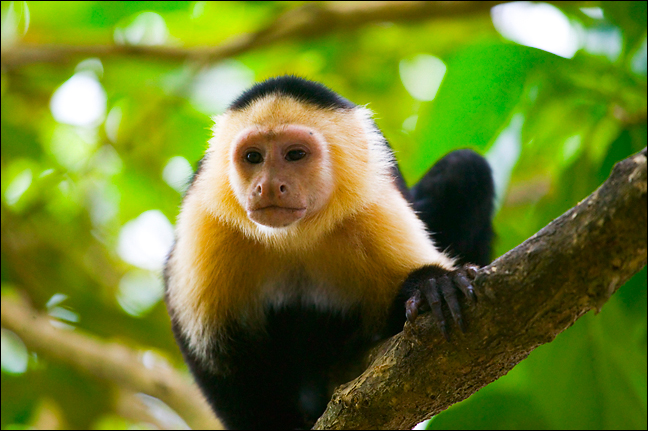
White-fronted capuchin(Cebus albifrons)
Phylum —chordata
Class — mammalia
Order — primates
Family — cebidae
Genus –cebus
Appearance
White-fronted capuchin(Cebus albifrons)
Phylum —chordata
Class — mammalia
Order — primates
Family — cebidae
Genus –cebus
Appearance
Male White-fronted capuchins usually weigh an average of 3.4 kg (7.5 lb) and the females an average of 2.9 kg (6.4 lb).
Their head is small compared to their body, their torso is slender and they have long, narrow limbs. They are a light brown color on their back and lighter underneath, often in shades of red and yellow. The fur on their back is long and soft, in contrast to the short coarser fur of their underparts. The crown of their head has a dark, round patch. Females sometimes possess a tuft of hair behind this patch. Their face is sparsely covered with pale colored hair, through which their peach-colored flesh can be seen. The color of their limbs ranges from yellows to reddy browns. The males are larger than females and the male’s tail may have a lighter tip.
Habitat
White-fronted capuchins inhabit northwestern South America, including Columbia, Ecuador, Venezuela, eastern Peru, and a good part of Amazonian Brazil.
Behavior
These monkeys are diurnal and arboreal. Except for nap around midday, they spend the whole day foraging. They sleep in trees at night, wedged in between branches. They live in groups which have 6 to 40 members, consisting of related females and young, and several males. Mutual grooming and vocalization acts as communication and stabilization within the group. They are territorial animals, clearly marking with urine an area in the center of their territory and actively defending it against intruders.
Diet
The capuchins are omnivores, eating fruits, birds’ eggs and small animals that they forage for at all levels in the forest. Food sources during drought can be nectar, palm nuts and figs. Capuchins that live near water also eat shellfish and crabs by cracking open their shells with stones.
Reproduction
These monkeys are polygynous. Groups are usually dominated by one male, with primary rights to breed with any of the females in the group. Females who are ready to mate actively respond to males seeking a mate. They don’t have a season for breeding, with mating periods being determined by location. Females bear a single young baby every 1 to 2 years, after a gestation of 150 to 160 days. Young cling tightly to their mother's chest, then after several weeks they change from a sideways over the shoulder position to riding on their mother’s back. As the baby develops, it starts to move about on its own, exploring the home range. It will nurse for a few months. At about 4 years for females, 8 for males, young become fully mature.
In captivity
Their average lifespan is up to 44 years in captivity.
It is better to install a special enclosure. The enclosure itself is a metal structure, with a large pallet at the bottom. Dimensions depend on the possibilities, but please note that the length of the enclosure should not be less than 1.5 meters. You should take into account the fact that the monkey will grow up and it may be too small. Inside the enclosure, you should hang ropes, put all sorts of stairs, because this animal is very mobile. There are people who keep monkeys without cages, but still it will be better if you build a special corner for it.
At home, it is necessary to diversify its diet. They are characterized by a disease such as diabetes, so the use of foods made from sugar or with added sugar should be taken under control. Fruits, various vegetables, in various forms are a good variety for nutrition. These monkeys are very fond of crickets and similar insects. From time to time, they can add meat and fish products to their food. But it is still better to consult with a veterinarian, who will tell you exactly what diet your petshould keep.
 Russian
Russian
 English
English























